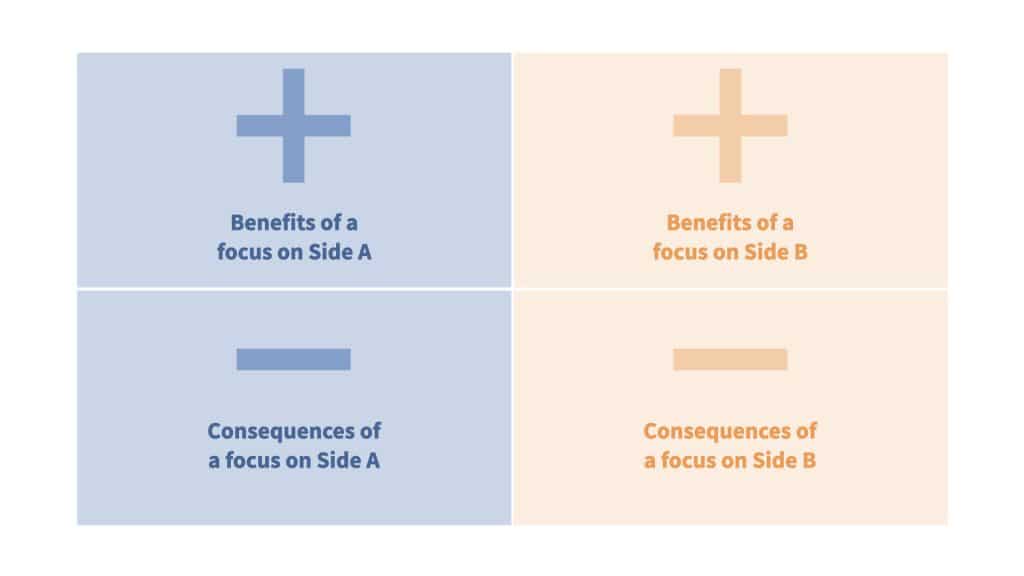Have you ever noticed how some team conversations go round in circles?
One person says, “We need more structure.”
Someone else fires back, “No, we need to stay flexible.”
And suddenly you’re stuck. Again.
This happens because some tensions at work aren’t problems you can solve.
They’re polarities you need to manage.
Structure and flexibility.
Speed and quality.
Short-term results and long-term vision.
In this article, I’ll walk you through a practical tool called the Polarity Map.
I’ll also share a 1-hour workshop you can use to help your team stop arguing about which side is right and start working out how to get the best of both.
Polarity Mapping was developed by Barry Johnson in the 1970s and formally introduced in his 1992 book Polarity Management: Identifying and Managing Unsolvable Problems.
Why does this matter?
Because most teams waste time stuck in either-or debates.
They pick a side, push hard on it, and over time... the weaknesses of that side show up.
So they swing back the other way.
And the cycle repeats.
I’ve seen teams flip from “total freedom” to “rigid rules” and back again in the space of a year.
Neither side really worked.
They weren’t seeing the bigger picture.
Here's what most people miss
The goal isn’t to find the perfect answer.
It’s to keep balancing both sides over time.
That’s not easy, but it’s possible when you map out what’s happening, name the upsides and downsides, and put some practical actions in place.
And in my experience, when teams finally see this pattern, something shifts.
They stop blaming each other.
They start managing the tension together.
What will your team gain from this workshop?
- A practical way to explore and manage a real tension, not just talk about it.
- Clear insight into why both sides of the issue matter.
- A shared language to help reduce unproductive debate.
- Action steps your team can use straight away.
- A tool you can apply to future team challenges.
Want to learn how the workshop works in practice?
Let’s get into it…
Workshop Title
Finding Balance: Using Polarity Maps to Navigate Team Tensions
Duration: 1 hour
Workshop Objectives
- Help the team explore a real tension they face.
- Teach them how to use a polarity map to balance competing values.
- Leave them with a clear next step to apply in their work.
Materials Needed
- Flipcharts or whiteboard (physical or virtual)
- Sticky notes or virtual sticky tools (e.g. Miro, MURAL, Jamboard)
- Pre-prepared blank polarity map template (4 quadrants)
Workshop Plan
Welcome and purpose (10 min)
- Explain:
- "Today we’re testing if Scrum feels useful, not committing to it forever."
- "We’ll try some key Scrum practices and reflect at the end."
- Ask:
- "What questions or concerns do you have about Scrum?"
- Capture on the board to revisit later.
Welcome and warm-up (5 min)
- Ask: “Think of a time when two opposite ideas were both true for your work. What were they?”
- Get 2-3 quick shares.
- Explain: “That’s what we call a polarity, not a problem. Today, we’ll learn how to balance them.”
Identify a real team tension (10 min)
- Ask: “What’s one recurring tension we face as a team?”, e.g.:
- Planning vs action
- Flexibility vs structure
- Individual needs vs team goals
- Capture suggestions on a board.
- Vote quickly and pick one to map together.
Build the polarity map (20 min)
Use a simple 4-quadrant polarity map:

Keep it quick and collaborative. Use sticky notes or type into a shared space:
- Top left: “What’s great when we focus on [side A]?” (capture responses)
- Top right: “What’s great when we focus on [side B]?”
- Bottom left: “What happens if we over-focus on [side A]?”
- Bottom right: “What happens if we over-focus on [side B]?”
Spot the warning signs and actions (15 min)
- Ask: “What signs will tell us we’re going too far one way?” Capture 3-5 warning signs.
- Ask: “What small actions could help us stay balanced?” Capture practical steps the team can take next week.
Reflection and close (10 min)
- Ask: “What’s one insight you’re taking from this conversation?”
- Ask: “Where else could we use this tool as a team?”
- Agree on 1-2 next steps for applying the polarity map insight in your work.
Facilitation Tips
- Keep energy high—don’t let them overthink.
- Stay neutral—don’t favour one side.
- Draw out quieter voices by inviting individuals by name.
- Reframe conflict as healthy tension, not something to fix.
- Summarise key points visually as you go.
Conclusion
So here’s the takeaway.
Tensions in your team aren’t going away.
Structure versus flexibility. Focus versus freedom. Stability versus change.
You can try to solve them. Pick a side. Push harder. And watch the same problems creep back again later.
Or you can help your team see the bigger picture. See the value in both sides. And learn to manage the tension together.
That’s what polarity maps give you.
Not a perfect solution, but a practical way forward.
If your team is stuck in the same arguments, try this workshop.
You don’t need fancy tools.
You need an open conversation, a simple framework and a bit of curiosity.
The best teams aren’t the ones that agree on everything.
They’re the ones who know how to balance what matters most.
That balance is where your real results come from.
See you next week.

